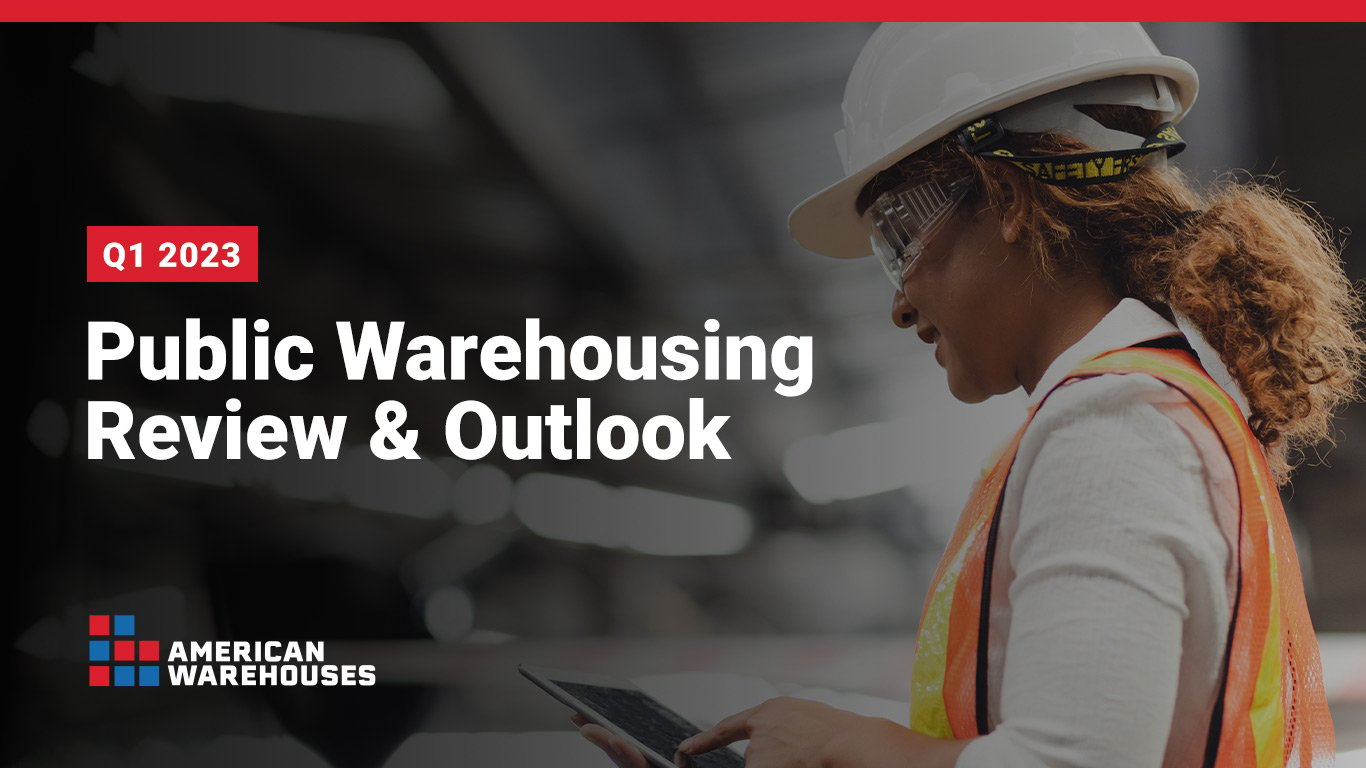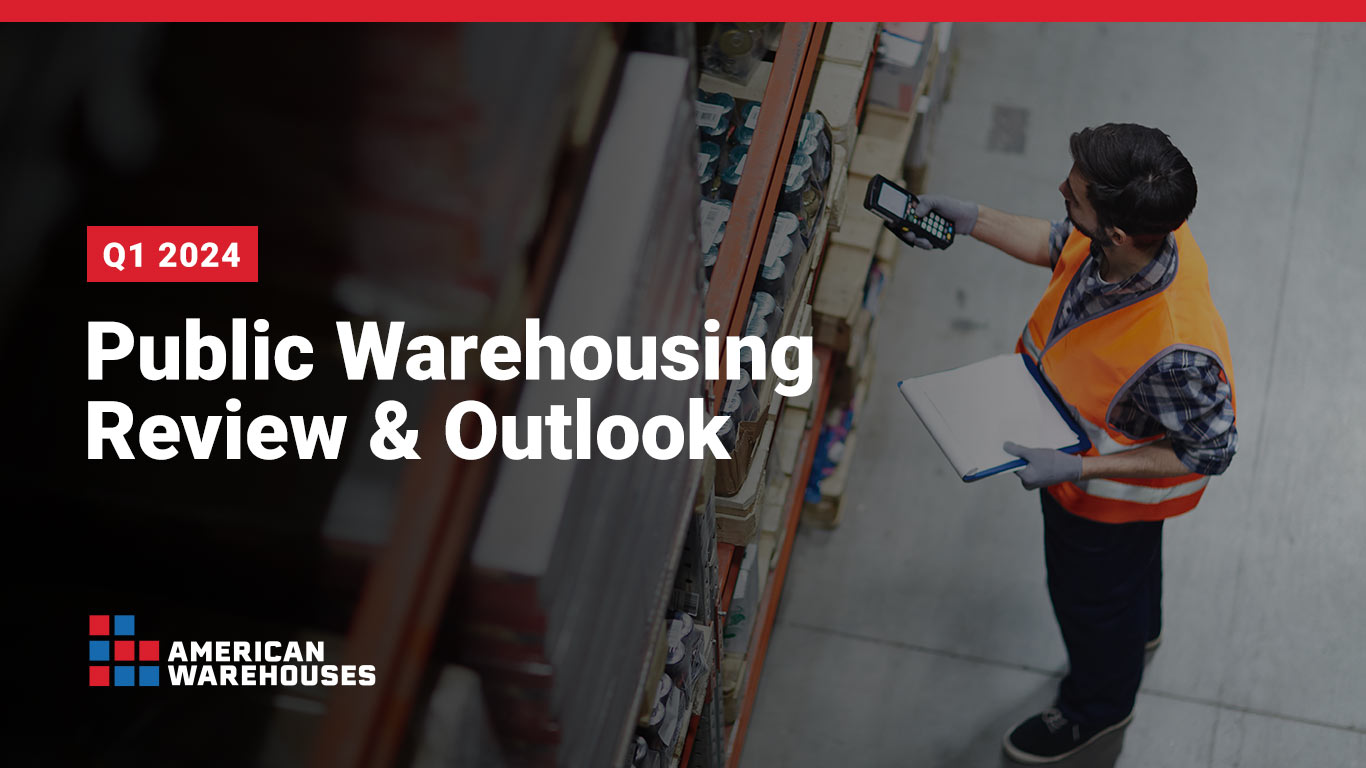Q1 Public Warehousing Review & Outlook

As a critical component of the logistics and supply chain management landscape, public warehousing provides companies safe storage of goods, as well as combustible chemicals and hazardous materials.
With basic storage functions, as well as value-added services including inventory management, shipping and delivering, automation and others, the global public warehousing market is expected to grow more than 6 percent through 2024. This is due to several factors, such as quicker order fulfillment and continued outsourced third-party logistics (3PL) provider demand.
Emerging technologies and trends are also shaping the way organizations approach storage and logistics. These include warehouse management systems (WMS), automated storage and retrieval systems (ASRS), Artificial Intelligence (AI) and the Internet of Things (IoT).
In this quarterly report, we’ll discuss the current state of public warehousing, challenges and opportunities, as well as key trends, technology innovations and more.
2023 Q1 Recap & Q2 Predictions
Previously holding the title for public warehousing, California has now been overtaken by Texas due to current logistics constraints and a shortage of developable land. Texas has risen to the top position, particularly as more shippers are redirecting their goods through Mexico and the Port of Houston.
Along with the shifting location of public warehousing, environmental impacts will also be a focus throughout 2023. This is especially imperative for public warehouse providers storing combustible chemicals, household products and other potentially hazardous materials.
Shippers have spent the last two years in survival mode. As such, most decisions were reactionary, rather than proactive. This signals that the 2023 public warehousing space will undoubtedly be shaped by several factors, mainly technology, sustainability and consumer behavior.
- Supply chain managers will continue to examine new strategies and additional business models.
- Public warehousing spaces will now serve as trusted advisers to shippers looking to diversify or expand storage and distribution needs.
- E-commerce will drive increased demand as companies focus on quicker, faster and more efficient deliveries.
- Companies will gravitate toward warehouses with sustainable business practices based on green initiatives.
Current Industry Challenges
In the wake of the 2020 coronavirus pandemic, supply chain managers have faced a plethora of challenges. Of the many obstacles, inflation, labor shortages and shipping constraints remain at the forefront. As a result, the industry is undergoing a shift towards automated technologies such as WMS, AI and ASRS.
Many of these challenges have forced shippers to implement cost-cutting measures requiring out-of-the box thinking via outsourced 3PLs, such as American Warehouses. The 33rd Annual State of Logistics Report conducted by the Council of Supply of Chain Professionals notes how 3PLs are now considered trusted, strategic partners.
Additional industry challenges will include:
- Public warehouses must work with shippers to stay ahead of inflation. This includes accurate forecasting to manage potential disruptions while staying within budgets.
- Due to 2021 and 2022 backlogs and excess goods, supply will likely outweigh demand, especially if inflation remains. Having real-time data available from a public warehouse operation can help assess and amend these.
- Data Security Threats: While adding new technologies can help automate and streamline warehouse processes, there are also potential cyber threats to consider. Ensuring public warehouse facilities have proper security protocols will be paramount as these technologies become more common.
Safety & Quality Control Measures
As a public warehouse entrusted with the storage and transportation of combustible chemicals and hazardous materials, staying up-to-date with regulations and mandates is of utmost importance. This encompasses maintaining safe and dependable equipment and working conditions, as well as protecting the environment, public health and the well-being of staff.
Despite warehouses having a higher injury and fatality rate than other industries, fewer injuries and illnesses were reported in 2020—a 5.7 percent decrease from the previous year.
While OSHA doesn’t have industry-specific regulations, the agency instead outlines safe guidelines and best practices within their General Duty Clause.
Learn more about what to look for when engaging with any public warehouse or storage facility:
- Proper Storage Precautions: This includes placing hazardous chemicals in well-ventilated areas, separate from other goods. The area should also have other protection measures, such as fire-resistant walls, floors and ceilings.
- Fire & Life Safety Devices: A safe public warehouse should always feature updated and regularly inspected smoke and carbon monoxide detectors, fire alarms, sprinkler systems and other fire suppression equipment.
- Labeled Warnings: Any hazardous materials should be appropriately identified with specifications, such as chemical name, potential dangers and emergency contact information.
- Regulatory Compliance: This includes all measures mandated by various safety organizations, such as OSHA, Environmental Protection Agency (EPA) and others.
- Training: Employees are regularly educated on safe handling, storage and movement of these materials.
- Emergency Response Planning: This outlines specific procedures for spills, leaks and other hazards. Every plan should include evacuation routes, shut-off procedures and emergency contacts.
Warehouse Management Systems (WMS) & Automation Technologies
With the global warehouse automation market set to reach a value of $30 billion by 2026, more and more public warehouses are streamlining operations and productivity.
American Warehouses achieves automation with its technologically advanced WMS. Tracking various data points, this technology provides real-time visibility on inventory levels and location, for more informed decisions on order fulfillment. WMS can also decrease time spent on picking and packing, as well as minimize errors.
Additional technologies to watch in 2023 include:
- ASRS is gaining traction to help with efficiencies, and minimizing costs and errors. It can also help address the current labor shortage.
- AI and IoT can help with important functions such as inventory management and warehouse layout, and real-time goods tracking, location and condition.
- These cloud-based systems enable warehouse operators to optimize labor while providing effective inventory control, and visibility regarding stored products.
Houston, Texas: A Centrally Located Warehouse & Logistics Hub
American Warehouses is strategically situated in the transportation hub and port city of Houston, merely 50 miles from the Gulf of Mexico. As a frequently used U.S. East and West Coast port alternative, this location proves to be advantageous.
Additionally, air and intermodal transportation are conveniently accessible from American Warehouses. The facility offers direct access to major airports and rail services in Houston, providing shippers with a convenient storage option before shipping goods throughout the United States, as well as serving as a gateway to Mexico.
Other key advantages of Houston’s transportation system include:
- A trio of Class I railways boasting more than 800 miles of track and 24 regional rail yards.
- The Port of Houston is the largest container port on the Gulf Coast with 70 percent of area container traffic.
- The City of Houston boasts more than 20 highway systems, such as 1-10, I-45, I-65 and the I-610 Loop.
- In July 2022, the Port of Houston began its Project 11 Dredging to assist in completion of Segment 3—the Barbours Cut Container Terminal section. This will help with handling larger vessels and additional cargoes.
- The Texas Department of Transportation also slated several highway improvement projects for the Houston area.
The Takeaway
Public warehousing is on a growth trajectory, driven by factors such as price, service quality and more. This trend is particularly evident in Texas, where Houston is emerging as an ideal location for efficient storage and logistics services for all types of goods, including hazardous materials and chemicals. The city's strategic position, combined with these favorable factors, make it a wise choice for businesses seeking dependable storage solutions.
When it comes to public warehousing, working with an experienced operator with established relationships and state-of-the-art facilities is crucial. At American Warehouses, we possess the expertise, location and cutting-edge technologies necessary to guarantee that your goods and supply chain are always handled with the utmost levels of quality control and safety, no matter the circumstance.
For the last 75 years, we’ve taken pride in offering our clients dependable and efficient storage solutions.

